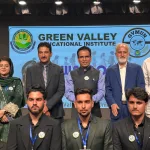Developmental disabilities are common. Yet, children with developmental disabilities have been neglected in health systems planning and policy provisions for health and continue to experience stigmatization, institutionalization, barriers to access health care and inequalities in health and education outcomes.
Using findings from research and practice and guided by the tenets of international human rights conventions, A WHO-UNICEF Global Report on children with developmental disabilities provides principles and approaches to intentionally include the needs and aspirations of children and young people with developmental disabilities in policy, programming and public health monitoring.
Every child and young person has the right to enjoythe highest attainable standard of health and wellbeing. The realization of this right depends on the capacity of governments to ensure safe, healthy, enabling, inclusive environments; universal access tohealth care and education; and equitable opportunitiesfor participation in all realms of life. Yet, due to theclustering of vulnerabilities and the failure of societiesto ensure inclusion, universal health coverage andenabling environments for all, children and youngpeople with developmental disabilities are more likelyto experience adversities, such as stigmatization, violence, poverty, school dropout and parental mentalillness. They are also more likely to experience poorhealth and have unmet health care needs, and aredeprived of opportunities to thrive.
Children and young people with developmental disabilities are a large and growing population. In 2019, there were approximately 317 million children and adolescents with health conditions that contribute to developmental disabilities globally. But across the world, their needs have been neglected in health systems planning and policy provisions for health.
At the same time, children and young people with developmental disabilities continue to experience stigmatization, prejudice, institutionalization and barriers to participation, as well as social, economic, educational and other forms of exclusion. They encounter barriers in accessing health care and receive poorer quality care compared with their peers.
The net effect of these omissions and exclusions is widespread inequalities in health outcomes and increased risk of dying prematurely for children, young people and adults with developmental disabilities.
Evidence from neuroscience, genetics, developmental psychology and other fields demonstrates that human brain development is most malleable in the earliest periods of life, from conception until adolescence, and that development can be supported by promoting nurturing interactions within the child’s environment. Individuals are most vulnerable to risk during early development; whenthey can be set on individual optimal developmental trajectories. Biological, social, political and physical environments have enormous effects on human characteristics during the earliest, most rapid periods of development.
The same notion of brain plasticity and conditions of optimal development apply to children with developmental disabilities. In children with developmental disabilities the underlying health conditions are not fixed and finite conditions with unchangeable effects on developmental programming. On the contrary, a range of biological and environmental factors influence development and health trajectories. For optimal development, regardless of functioning, children and young people require certain “inputs” from their environment.
An ecological framework or model acknowledges the embedded nature of human development and demonstrates the various levels at which “inputs” can be made to development. It also recognizes that the relations between children and their environments are bidirectional; as much as an environment may influence a child, a child may influence their environment, particularly at the micro level. As children with developmental disabilities may face barriers in accessing nurturing interactions within families, communities and with peers, tailored responses, such as early interventions to enhance shared engagement and participation must be applied and be sustained during childhood, adolescence and the life-course. An ecological framework for considering children and young people with developmental disabilities situates individual development within concentric circles of influence radiating outwards, including family, community, institutions, policy and the environment.
The health, well-being and participation of children and young people with developmental disabilities have been promoted in international legal documents in the sectors of both disability and child rights, including the United Nations Convention on the Rights of Persons with Disabilities (UNCRPD) and the United Nations Convention on the Rights of the Child (UNCRC). Yet, children and young people with developmental disabilities experience stigmatization, prejudice, institutionalization, barriers to participation and social, economic, educational and other forms of exclusion. Many of them grow up in conditions of poverty and scarce resources. Ecological instability and environmental threats, war, violence and other types of adversity influence children’s health. These conditions often have cumulative effects. Thus, the more intersecting adversities and layers of marginalization that a child or young person faces, the greater their risk of poor health and well-being.
A life-course perspective on developmental disabilities means looking at how all the experiences throughout the life of a person with a developmental disability, from preconception onwards, can affect their development and well-being. This includes considering how different experiences interact with each other over time and providing support to individuals with disabilities and their families during major life transitions. This perspective goes beyond a single age group and considers the child or young person as an individual moving throughdifferent developmental periods, each period being influenced by events in the preceding period, and each current period laying the foundation for the next phase of life.
Different aspects of socioeconomic position may be related to different downstream risk factors. Poverty and low parental education have been clearly linked to factors such as poorer nutrition, poorer housing conditions, less optimal parenting practices and health-related behaviors, and poorer access to health and supportive interventions. Minority ethnic status, indigeneity and immigrant status may be particularly closely related to reduced access to health and supportive interventions, including for prenatal and perinatal care. Parental disability related to mental health without essential supports may result in less than optimal parenting.
A recent report published by the World Health Organization (WHO) and UNICEF highlights the global prevalence of developmental disabilities among children and young people, shedding light on the urgent action needed to address disparities in their access to healthcare, health outcomes, and exposure to social determinants such as poverty.
The report estimates that – in 2019 – 317 million children and young people were affected by health conditions contributing to a developmental disability. Many of them experience stigmatization, prejudice, and social exclusion. They also encounter barriers in accessing health care and experience poorer quality of care when compared with their peers.
“The vision of leaving no one behind can only be achieved if the aspirations and needs of children and young people with developmental disabilities are brought from the margins to the mainstream of our work in promoting the health and well-being of children all over the world” Dr. Luwei Pearson, Associate Director of Health, UNICEF has said.
“From poorer health outcomes to social exclusion, children and young people with developmental disabilities experience vast disparities. By strengthening interventions to support children and young people with developmental disabilities within wider efforts to boost universal health coverage and promote inclusive nurturing environments, we can ensure they have access to the resources and services they need to live healthy lives” said Dévora Kestel, Director for Mental Health and Substance Use, WHO.
Children and young people with developmental disabilities have underlying health conditions which affect the developing nervous system and cause impairments in motor, cognitive, language, behaviour and/or sensory functioning and associated disabilities. In interaction with various barriers and contextual factors, these impairments may hinder a child’s full and effective participation in society on an equal basis with others.
Underlying health conditions which contribute to developmental disabilities include autism, disorders of intellectual development, attention deficit hyperactivity disorder and many other neurodevelopment disorders listed in the International Classification of Diseases, 11th Revision (ICD-11) and also a much broader group of congenital conditions (such as Down syndrome) or conditions acquired at birth (such as cerebral palsy) or during childhood.
Evidence shows that the children with developmental disabilities experience poorer health and higher risk of premature mortality than their peers. The most common underlying, avoidable causes of death in children and young people with developmental disabilities include epilepsy, choking, respiratory infections and injuries.
Health disparities also extend into adulthood, increasing the risks of conditions such as diabetes, heart disease, obesity, respiratory illnesses, and mental health conditions.
People with developmental disabilities have unmet healthcare needs due to fragmented and underfunded health care systems. Children and young people with developmental disabilities often experience undetected and untreated health issues, hampered by delayed diagnoses, lengthy waiting lists and ineligibility for care services. A lack of information, stigma and limited understanding of developmental disabilities also act as barriers to accessing health care.
Physical and attitudinal barriers and lack of training further contribute to inequitable health care for these children. Quality of care varies widely with children with developmental disabilities experiencing more preventable harms and poorer care quality during hospital stays.
Recent advances in advocacy, brain science, human rights, disability frameworks and positioning of disability and neurodevelopmental conditions in global development and public health agendas contribute approaches to optimizing the health and well-being of children and young people with developmental disabilities.
This global report is a call for action to accelerate changes at individual, family, community and society levels to achieve inclusion and health equity. It makes the case for greater investment to build responsive multisectoral care systems for children and young people with developmental disabilities. Using findings from research and practice and guided by international human rights conventions, this global report provides key insights into the state of knowledge, policy, programming and public monitoring in respect of developmental disabilities.
Sustainable, equitable strategies to prevent and treat coexisting health conditions and to promote development, well-being and functioning are central to achievement of this goal. The global public health commitments of universal access to health care will not be achieved without the full and meaningful inclusion of children and young people with developmental disabilities.
(The author is a freelance columnist and can be mailed at [email protected]). Twitter: @haniefmha)





